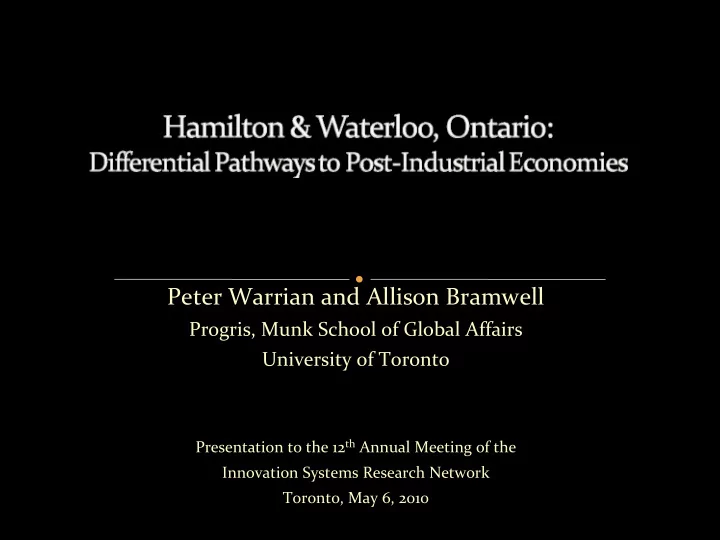

Peter Warrian and Allison Bramwell Progris, Munk School of Global Affairs University of Toronto Presentation to the 12 th Annual Meeting of the Innovation Systems Research Network Toronto, May 6, 2010
� 1960: Two Midsized Industrial Cities � Dominant Manufacturing Firms � Primary Industries: Steel, rubber, appliances, footwear, tires, automotive � Services: Waterloo Insurance � Universities with Technical Strength � Hamilton superior in engineering, science and humanities � Waterloo: emergent coop engineering, mathematics � Engineering Labour Markets � Hamilton advantage
� Role of Universities � 1960s: University ‐ based Innovations � Waterloo: � Tipping Point: The Compiler � Hamilton: � John Evans and McMaster Medical School
� Hamilton Model: Bipolar Dynamics � Health Sciences: McMaster, HHS � Steel/ Manufacturing: � De ‐ Verticalization, Labour Shedding of existing industrial firms � Disaggregation of firms and industries into supply chains and knowledge networks � Waterloo Model: Diversified Industrial Base � University of Waterloo: IP and spin ‐ offs � Role of the Co ‐ op program � Links to high tech and advanced manufacturing
� Global Steel Knowledge Networks � Global benchmarking: capital and technology � Managerial talent flows � New product development model � Formal Governance � Steel executives: Health Sciences � Chairs of the Board and key committees � Complexity on the Ground � Gap in venture capital markets for firms � Services model ‐ alternative financing � USWA & CAW benefit plans: � base for services innovation
� Talent Flows: � Thickening of Engineering Labour Markets � Process Innovation and Colleges
� Role of Public Research Infrastructure � New steel � Emergence of asymmetric knowledge networks (Cooke) � Product development and materials competition � Knowledge Spillovers: Specialization/General Knowledge � Net flow of human resources from old to new economy � Unique to Hamilton is the impact of unions and old economy labour market institutions on the demand side � Hamilton Health Sciences is source of ideas. � Union agreements enable innovations to be implemented
� Highly diversified industrial economy � Strength in ICT’s, advanced manufacturing and automotive � Significant financial services sector � Strong civic capital and cohesive development coalition � Selective & targetted strategic planning � Strategic use of federal and provincial resources � Effective policy alignment � Strong research infrastructure � Two universities, plus one community college � But scores low on bohemian index
� Disconnect between reputation for spin ‐ offs and actual impact since 1990s � Little collaboration with university on R&D � Short ‐ term problem solving � Students critical agents for knowledge transfer � Big ‘D’, little ‘R’ � Focused on incremental innovations or process innovation � Knowledge flows primarily intra ‐ firm or intra ‐ sectoral � Shift towards ‘cognitive ‐ cultural’ economy � Stratford Institute, Kitchener Digital Media and Mobility Accelerator Hub
� Business Organization � Social Welfare Interests � Arts and Culture � Community Wide Governance Efforts � Hamilton: � Past: Rotary Club as civic leaders & business network � Present: Active civil society, but business vacuum � Waterloo: � Business ‐ led Associative Governance
� Business organization is weak in Hamilton: � primarily the Chamber of Commerce � Economic development function located in City government � Few private not ‐ for ‐ profit associations � No organization represents emerging industries in health care diagnostics � Golden Horseshoe Biosciences Network (GHBN) � Business organization is strong in Waterloo: � Communitech, CTT and Prosperity Council � Interlinked & overlapping private not ‐ for ‐ profit organizations: � Focused on industrial and high tech activities
� Highly organized & visible in Hamilton � Innovative governance mechanism to promote collaboration � Hamilton Roundtable for Poverty Reduction � Support of highly visible & highly engaged 'civic leader/entrepreneur' � Less organized & visible in Waterloo � Lutherwood � Linchpin service organization in the community � but weak in comparison to Hamilton � Limited participation from core civic groups on poverty reduction at regional level
� Hamilton, very 'bottom ‐ up' grass roots � Civic entrepreneur � Imperial Cotton Centre for the Arts ‐ affordable studio space for artists in abandoned downtown warehouses � Spontaneous development of the Art Crawl on James St. � City of Hamilton: Creative Catalyst project � Waterloo arts community less visible � Efforts to attract artists but more for talent attraction that for broader community development � Recent efforts by Waterloo Region Tourism Marketing Corp and Waterloo Region Arts Council to bring arts and culture groups together
� Hamilton has a community ‐ wide governance mechanism: � Jobs Prosperity Collaborative (JPC) � Constructed around the theme of ‘jobs’ to maintain buy ‐ in from wide range of interests � Civic entrepreneur is Co ‐ Chair of both JPC and HRPR � Wide range of representatives from the community � Economic development, environment, arts and culture, immigrants � Truly innovative approach to community ‐ led development
� Waterloo tends to be more siloed � Strong business development focus � Social welfare issues not as visible on the agendas of core actors and governance groups � Support development of arts and culture � Primarily as a talent attraction strategy rather than in their own right as a public good for the community � Greater recognition of importance of arts and culture than previously
� Economic Trajectories of Mid ‐ Sized versus Large, Metropolitan Cities � Greater divergence through time � Path dependency is a more critical factor � Regional benefit outcomes of universities are more important � Civic governance factors can lead to resilience or downward spiral � Local civic learning processes � Hamilton focused on learning from Waterloo
Recommend
More recommend